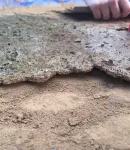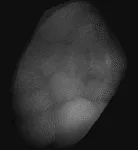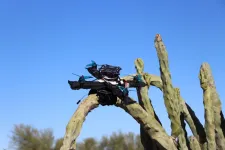(Press-News.org) In the arid regions of the American Southwest, an unseen world lies beneath our feet. Biocrusts, or biological soil crusts, are communities of living organisms. These industrious microbes include cyanobacteria, green algae, fungi, lichens, and mosses, forming a thin layer on the surface of soils in arid and semi-arid ecosystems.
Biocrusts play a crucial role in maintaining soil health and ecosystem sustainability, but they are currently under assault. Human activities including agriculture, urbanization, and off-road vehicle use can lead to the degradation of biocrusts, which have long-term consequences for these fragile environments. Climate change is also placing stress on biocrusts, which struggle to adapt to sunlight and searing heat in arid landscapes like the Sonoran Desert.
Now, Ferran Garcia-Pichel and his student at Arizona State University propose an innovative approach to restoring healthy biocrusts. The idea is to use new and existing solar energy farms as nurseries for generating fresh biocrust.
Safely shielded from the sun beneath arrays of solar panels, like beachgoers under an umbrella, the biocrusts are sheltered from excessive heat and can flourish and develop. Ultimately, the newly generated biocrusts can then be used to replenish arid lands where such soils have been damaged or destroyed.
℞ for desert soil
In a proof-of-concept study, ASU researchers adapted a suburban solar farm in the lower Sonoran Desert as an experimental breeding ground for biocrust. During the three-year study, photovoltaic panels promoted biocrust formation, doubling biocrust biomass and tripling biocrust cover compared with open areas with similar soil characteristics.
When biocrusts were harvested, natural recovery was moderate, taking around 6-8 years to fully recuperate without intervention. However, when harvested areas were re-inoculated, the recovery was much faster, with biocrust cover reaching near-original levels within one year.
The researchers emphasize that the use of similar, but larger, solar farms could provide a low-cost, low-impact, and high-capacity method to regenerate biocrusts and expand soil restoration approaches to regional scales. They have dubbed their pioneering approach “crustivoltaics.”
The study estimates that use of the three largest solar farms in Maricopa County, Arizona as biocrust nurseries could empower a small-scale enterprise to rejuvenate all idle agricultural lands within the county, spanning more than 70,000 hectares, in under five years. Among many environmental benefits, this restoration effort has the potential to significantly decrease airborne dust presently impacting the Phoenix Metropolitan region.
“This technology can be a game changer for arid soil restoration,” Garcia-Pichel says. “For the first time reaching regional scales at our fingertips, and we could not be more excited. To boot, crustivoltaics represents a win-win approach for conservation of arid lands and for the energy industry alike.”
Garcia-Pichel is a Regents’ Professor in the School of Life Science and the founding director of the Biodesign Center for Fundamental & Applied Microbiomics. The center amalgamates researchers that study assemblages of microbes (or microbiomes) acting in unison in various settings, from humans to animals and plants, to oceans and deserts. Garcia-Pichel’s lab has specialized in the study and applications of desert soil microbiomes.
The group’s findings appear in the current issue of the journal Nature Sustainability, in a publication co-lead by graduate student Ana “Meches” Heredia-Velásquez, and former graduate student Dr. Ana Giraldo-Silva, now a professor at the Public University of Navarre in Spain. A separate briefing of this contribution appears concurrently in Nature.
Living matrix
Biocrusts are complex ecosystems researchers have only recently begun to explore. Among their many housekeeping functions, they act to stabilize soil by binding soil particles together, minimizing the loss of topsoil caused by wind and water. They contribute to nutrient cycling by fixing atmospheric nitrogen, a process where nitrogen gas is converted into ammonia, making it available to plants. Cyanobacteria, which are present in biocrusts, are the primary organisms responsible for this process.
Photosynthetic activities within biocrusts play a role in carbon storage by fixing atmospheric carbon dioxide. This process can help mitigate some of the effects of climate change by removing carbon dioxide from the atmosphere. Biocrusts also increase the soil's water-retaining capacity, allowing more water to infiltrate the soil and reducing runoff. This helps to improve water availability for plants and other organisms in arid ecosystems.
Finally, biocrusts support a diverse community of microorganisms that contribute to overall ecosystem biodiversity and resilience.
Drylands, which make up approximately 41% of the Earth's continental area, are experiencing severe degradation due to human activities and climate change. The communities of microorganisms on soil surfaces are vital to protect and fertilize these soils and are essential for dryland sustainability. However, current biocrust restoration methods involve high effort and low capacity, limiting their application to small areas. Existing methods have struggled to replenish more than a few hundred square meters of land.
Solar solutions
The research suggests that solar farms serve as biocrust hotspots, as the elevated photovoltaic panels create a greenhouse-like microclimate promoting biocrust development. Although crustivoltaics is a slower and weather-dependent method compared to greenhouse-sized biocrust nurseries, it has many advantages. The technique requires fewer resources, minimal management, and no upfront investment. Indeed, the use of crustivoltaics is 10,000 times more cost-effective than current methods, according to the research findings.
The next steps will involve implementing crustivoltaics at regional scales through the cooperation of scientists, collaborative agencies, land users and managers. Use of the technique can provide incentives to solar farm operators, including reduced dust formation on solar panels and increased revenue from carbon credits.
The crustivoltaic approach has the potential to offer a dual-use solution for both solar power generation and biocrust restoration on a large scale, while also providing socioeconomic benefits. This method could play a significant role in the restoration and sustainability of dryland ecosystems.
END
Using solar farms to generate fresh desert soil crust
ASU researchers discover new way to replace biocrusts damaged by human activities
2023-04-20
ELSE PRESS RELEASES FROM THIS DATE:
COVID-19 pandemic saw major increase in children and adolescents attempting suicide by poison, study finds
2023-04-20
The rate of suspected suicide attempts by poisoning among children and adolescents ages 10-19 reported to U.S. poison centers increased 30% during 2021 – the COVID-19 pandemic’s first full year – compared with 2019, a new UVA Health study found.
The rate of suspected suicide attempts by poisoning among children ages 10-12 increased 73% during 2021 compared with 2019. Among adolescents ages 13-15, the rate of suspected suicide attempts by poisoning increased 48.8% in 2021 versus 2019. The rate of suspected suicide attempts by poisoning among females ages 10-19 increased 36.8% in 2021 compared with 2019.
The findings ...
Pairing up: the impact of treating alcohol use disorder and PTSD together
2023-04-20
A collaborative multi-site randomized controlled trial at the University of Houston and the Medical University of South Carolina is set to prove the effectiveness of treating alcohol use disorder (AUD) and posttraumatic stress disorder (PTSD) together.
It’s a one-two punch whose time has come. No integrative treatment combining Cognitive processing therapy (CPT) for PTSD and relapse prevention (RP) for AUD currently exists.
“A substantial proportion of individuals with AUD also meet criteria for PTSD. The co-occurrence of AUD/PTSD is characterized by more severe symptomatology, greater functional impairment, ...
IU cancer researchers identify new target for breast cancer therapy
2023-04-20
INDIANAPOLIS—While trying to understand what initiates breast cells to become cancerous, researchers at the Vera Bradley Foundation Center for Breast Cancer Research at Indiana University Melvin and Bren Simon Comprehensive Cancer Center have identified a new target for breast cancer treatment.
“When comparing healthy breast tissue and cancerous cells, we wanted to find out what is the earliest genomic change that happens to initiate the cancer,” said Harikrishna Nakshatri, PhD, the Marian J. Morrison professor of breast cancer research ...
Hungry eyes: Spiders lose vision when they're starving
2023-04-20
Biologists at the University of Cincinnati discovered that underfed jumping spiders lose light-sensitive cells that are key to their vision.
UC College of Arts and Sciences Professor Elke Buschbeck and her co-authors studied photoreceptors in the eyes of bold jumping spiders, tiny eight-legged predators found across North America. The little hunters rely on their keen vision to stalk prey.
But researchers found that underfed spiders begin to lose photoreceptors that give them such good eyesight. Their findings could improve our understanding of ...
Cleveland Clinic research predicts cancer patients’ response to chemotherapy agent cisplatin
2023-04-20
Researchers at Cleveland Clinic have taken an important step in predicting which treatment will work for individual cancer patients. Using a gene signature developed from cell lines and human tissue, the research team demonstrated the ability to predict a patient’s response to the chemotherapy agent cisplatin, without relying on changes in the mutational status of a patient’s cancer. The study was recently published in NPJ Precision Oncology.
In recent years, effective new cancer treatments have ...
Built to bounce back
2023-04-20
Search and rescue efforts following disasters like the massive earthquakes in Turkey and Syria are a race against time. Emergency response teams need to quickly identify voids or spaces in building rubble where survivors might be trapped, and before natural gas leaks, water main flooding or shifting concrete slabs take their toll.
Advanced technology plays a vital role in these recovery operations. Thermal imaging equipment and sensitive listening devices are deployed to seek out signs of life. Small aerial ...
bioRxiv and PaperPlayer pilot a new feature to increase accessibility
2023-04-20
Cold Spring Harbor Laboratory announced today that its life sciences preprint server bioRxiv has partnered with PaperPlayer, a service for converting manuscripts into high-quality audio, to provide audio versions of preprint abstracts in the bioRxiv Neuroscience category. This new feature increases content accessibility and offers a way of obtaining information from preprints that’s an alternative to a screen. It is being piloted in the Neuroscience category to assess its value for preprint users.
"This ...
AI system can generate novel proteins that meet structural design targets
2023-04-20
MIT researchers are using artificial intelligence to design new proteins that go beyond those found in nature.
They developed machine-learning algorithms that can generate proteins with specific structural features, which could be used to make materials that have certain mechanical properties, like stiffness or elasticity. Such biologically inspired materials could potentially replace materials made from petroleum or ceramics, but with a much smaller carbon footprint.
The researchers from MIT, the MIT-IBM Watson AI Lab, and Tufts University employed a generative model, which is the same type of machine-learning model architecture ...
Why are networks stable?
2023-04-20
A single species invades an ecosystem causing its collapse. A cyberattack on the power system causes a major breakdown. These type of events are always on our mind, yet they rarely result in such significant consequences. So how is it that these systems are so stable and resilient that they can withstand such external disruptions? Indeed, these systems lack a central design or blueprint, and still, they exhibit exceptionally reliable functionality.
In the early 70s the field of ecology was split on the question of whether biodiversity is a good or a bad thing for an ecosystem. In 1972 Sir Robert May showed, mathematically, that an increase in biodiversity causes less ecological ...
Trends in severe outcomes among patients hospitalized with COVID-19
2023-04-20
About The Study: The findings of this study of 55,000 adult and pediatric patients hospitalized with laboratory-confirmed COVID-19 in Canada suggest that COVID-19 vaccination is important to reduce the burden on the Canadian health care system as well as severe outcomes associated with COVID-19.
Authors: Robyn Mitchell, M.H.Sc., of the Public Health Agency of Canada in Ottawa, is the corresponding author.
To access the embargoed study: Visit our For The Media website at this link https://media.jamanetwork.com/
(doi:10.1001/jamanetworkopen.2023.9050)
Editor’s ...
LAST 30 PRESS RELEASES:
Why some brains switch gears more efficiently than others
UVA’s Jundong Li wins ICDM’S 2025 Tao Li Award for data mining, machine learning
UVA’s low-power, high-performance computer power player Mircea Stan earns National Academy of Inventors fellowship
Not playing by the rules: USU researcher explores filamentous algae dynamics in rivers
Do our body clocks influence our risk of dementia?
Anthropologists offer new evidence of bipedalism in long-debated fossil discovery
Safer receipt paper from wood
Dosage-sensitive genes suggest no whole-genome duplications in ancestral angiosperm
First ancient human herpesvirus genomes document their deep history with humans
Why Some Bacteria Survive Antibiotics and How to Stop Them - New study reveals that bacteria can survive antibiotic treatment through two fundamentally different “shutdown modes”
UCLA study links scar healing to dangerous placenta condition
CHANGE-seq-BE finds off-target changes in the genome from base editors
The Journal of Nuclear Medicine Ahead-of-Print Tip Sheet: January 2, 2026
Delayed or absent first dose of measles, mumps, and rubella vaccination
Trends in US preterm birth rates by household income and race and ethnicity
Study identifies potential biomarker linked to progression and brain inflammation in multiple sclerosis
Many mothers in Norway do not show up for postnatal check-ups
Researchers want to find out why quick clay is so unstable
Superradiant spins show teamwork at the quantum scale
Cleveland Clinic Research links tumor bacteria to immunotherapy resistance in head and neck cancer
First Editorial of 2026: Resisting AI slop
Joint ground- and space-based observations reveal Saturn-mass rogue planet
Inheritable genetic variant offers protection against blood cancer risk and progression
Pigs settled Pacific islands alongside early human voyagers
A Coral reef’s daily pulse reshapes microbes in surrounding waters
EAST Tokamak experiments exceed plasma density limit, offering new approach to fusion ignition
Groundbreaking discovery reveals Africa’s oldest cremation pyre and complex ritual practices
First breathing ‘lung-on-chip’ developed using genetically identical cells
How people moved pigs across the Pacific
Interaction of climate change and human activity and its impact on plant diversity in Qinghai-Tibet plateau
[Press-News.org] Using solar farms to generate fresh desert soil crustASU researchers discover new way to replace biocrusts damaged by human activities





